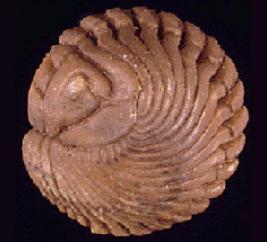CLASS CRUSTAEA
SUBCLASS TRILOBITA
Trilobita: Life History and Ecology
Most
trilobites lived in fairly shallow water and were benthic;
they walked on the bottom, and probably fed on detritus. A
few, like the agnostids, may have been pelagic, floating in
the water column. Cambrian and Ordovician trilobites generally
lived in shallow water. After the Ordovician, when many trilobite
groups declined or went extinct, the survivors tended to be
restricted to deeper water.
 Food
particles were stirred up by the legs and passed forward to
the mouth. Since the mouth had no large mandibles, we infer
that trilobites were not usually predatory and were restricted
to soft food. Some trilobites had long spines on the first
leg segment, the gnathobase; these may have been able to tear
up larger pieces of food, and probably scavenged for a living.
Food
particles were stirred up by the legs and passed forward to
the mouth. Since the mouth had no large mandibles, we infer
that trilobites were not usually predatory and were restricted
to soft food. Some trilobites had long spines on the first
leg segment, the gnathobase; these may have been able to tear
up larger pieces of food, and probably scavenged for a living.
Fossil
burrows and tracks have been found that match trilobite bodies
very precisely; these show that trilobites could burrow into
sediment to feed or to avoid predators. Many trilobites living
after the Cambrian developed the ability to roll up, also
probably as a defense against predators. In  the
two views of the specimen at right, Pliomera fischeri, from
the Ordovician of the St. Petersburg region of Russia, you
can see it is doing just that. Notice the notches in the pygidium
just where it contacts the glabella. In the living trilobite,
these would have allowed water to enter and flow over the
gills, so that the trilobite could breathe while
the
two views of the specimen at right, Pliomera fischeri, from
the Ordovician of the St. Petersburg region of Russia, you
can see it is doing just that. Notice the notches in the pygidium
just where it contacts the glabella. In the living trilobite,
these would have allowed water to enter and flow over the
gills, so that the trilobite could breathe while
enrolled.
Please
use the buttons to the left to access more information about
trilobites.
